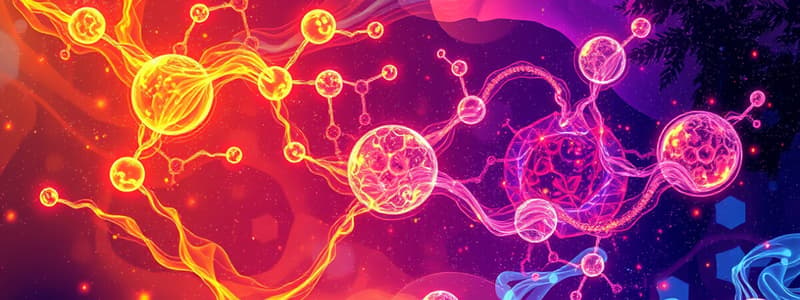Podcast
Questions and Answers
What is the ionic charge and name of the compound Li2O?
What is the ionic charge and name of the compound Li2O?
- Li+ and O2-; Lithium Oxide (correct)
- Li2- and O2+; Lithium Oxine
- Li2+ and O-; Lithium Oxygen
- Li+ and O-; Lithium Oxide
What is the ionic charge and name of the compound CaS?
What is the ionic charge and name of the compound CaS?
- Ca2+ and S2-; Calcium Sulfide (correct)
- Ca+ and S-; Calcium Sulfide
- Ca+ and S2-; Calcium Sulfide
- Ca2+ and S-; Calcium Sulfide
What is the ionic charge and name of the compound Mg3N2?
What is the ionic charge and name of the compound Mg3N2?
- Mg3+ and N2-; Magnesium Nitride
- Mg2+ and N3-; Magnesium Nitride (correct)
- Mg+ and N3-; Magnesium Nitride
- Mg2+ and N2-; Magnesium Nitride
What is the ionic charge and name of the compound Al2S3?
What is the ionic charge and name of the compound Al2S3?
What is the chemical formula for Cesium Oxide?
What is the chemical formula for Cesium Oxide?
What is the chemical formula for Sodium Selenide?
What is the chemical formula for Sodium Selenide?
What is the chemical formula for Lithium Sulfide?
What is the chemical formula for Lithium Sulfide?
What is the chemical formula for Calcium Iodide?
What is the chemical formula for Calcium Iodide?
Write the chemical formula for Ruthenium (III) Sulfide: __
Write the chemical formula for Ruthenium (III) Sulfide: __
Write the chemical formula for Scandium Fluoride: __
Write the chemical formula for Scandium Fluoride: __
Write the chemical formula for Osmium (VIII) Oxide: __
Write the chemical formula for Osmium (VIII) Oxide: __
Write the chemical formula for Manganese (II) Sulfide: __
Write the chemical formula for Manganese (II) Sulfide: __
Write the chemical formula for Thallium (III) Chloride: __
Write the chemical formula for Thallium (III) Chloride: __
Write the chemical formula for Zinc Arsenide: __
Write the chemical formula for Zinc Arsenide: __
For the equation carbon monoxide + oxygen --> carbon dioxide, write the balanced chemical formula: __
For the equation carbon monoxide + oxygen --> carbon dioxide, write the balanced chemical formula: __
For the equation cesium + bromine --> cesium bromide, write the balanced chemical formula: __
For the equation cesium + bromine --> cesium bromide, write the balanced chemical formula: __
For the equation nitrogen monoxide + oxygen --> nitrogen dioxide, write the balanced chemical formula: __
For the equation nitrogen monoxide + oxygen --> nitrogen dioxide, write the balanced chemical formula: __
For the equation ammonia + oxygen --> nitrogen monoxide + water, write the balanced chemical formula: __
For the equation ammonia + oxygen --> nitrogen monoxide + water, write the balanced chemical formula: __
Use electron configuration to describe the formation of AgCl from the atom: __
Use electron configuration to describe the formation of AgCl from the atom: __
Use electron configuration to describe the formation of Li3N from the atom: __
Use electron configuration to describe the formation of Li3N from the atom: __
Predict the ground state electron configuration of Ru2+:
Predict the ground state electron configuration of Ru2+:
Predict the ground state electron configuration of W3+:
Predict the ground state electron configuration of W3+:
Predict the ground state electron configuration of Pd2+:
Predict the ground state electron configuration of Pd2+:
Predict the ground state electron configuration of Ti+:
Predict the ground state electron configuration of Ti+:
How many d electrons are there in Fe2+?
How many d electrons are there in Fe2+?
How many d electrons are there in Zn2+?
How many d electrons are there in Zn2+?
How many d electrons are there in Mn2+?
How many d electrons are there in Mn2+?
How many d electrons are there in Ni2+?
How many d electrons are there in Ni2+?
Predict which of the following pairs has the larger relative size: H+ and H.
Predict which of the following pairs has the larger relative size: H+ and H.
Predict which of the following pairs has the larger relative size: S and S2-.
Predict which of the following pairs has the larger relative size: S and S2-.
Predict which of the following pairs has the larger relative size: Fe2+ and Fe3+.
Predict which of the following pairs has the larger relative size: Fe2+ and Fe3+.
Predict which of the following pairs has the larger relative size: Ca2+ and Cl-.
Predict which of the following pairs has the larger relative size: Ca2+ and Cl-.
Predict which of the following pairs has the larger relative size: Mn2+ and Cr+.
Predict which of the following pairs has the larger relative size: Mn2+ and Cr+.
List the following ions in order of increasing radius: Y3+, Br-, Se2-, Rb+, Mo6+: __
List the following ions in order of increasing radius: Y3+, Br-, Se2-, Rb+, Mo6+: __
Explain why the magnitude of the first electron affinity of a chlorine atom is greater than that of a sulfur atom.
Explain why the magnitude of the first electron affinity of a chlorine atom is greater than that of a sulfur atom.
Explain why cations are smaller and anions are larger than their neutral parent atoms.
Explain why cations are smaller and anions are larger than their neutral parent atoms.
List three ions that are isoelectronic with F-: __
List three ions that are isoelectronic with F-: __
How many unpaired electrons are there in an Fe3+ ion?
How many unpaired electrons are there in an Fe3+ ion?
How many unpaired electrons are there in a Cu+ ion?
How many unpaired electrons are there in a Cu+ ion?
Which of the following anions would you predict to be the smallest: phosphide, sulfide, or chloride?
Which of the following anions would you predict to be the smallest: phosphide, sulfide, or chloride?
Flashcards are hidden until you start studying
Study Notes
Ionic Compounds and Their Formulas
- Li2O: Composed of lithium ions (Li+) and oxide ions (O2-); named lithium oxide.
- CaS: Contains calcium ions (Ca2+) and sulfide ions (S2-); known as calcium sulfide.
- Mg3N2: Consists of magnesium ions (Mg2+) and nitride ions (N3-); referred to as magnesium nitride.
- Al2S3: Made up of aluminum ions (Al3+) and sulfide ions (S2-); called aluminum sulfide.
- Cesium oxide: Chemical formula is Cs2O.
- Sodium selenide: Chemical formula is Na2Se.
- Lithium sulfide: Chemical formula is Li2S.
- Calcium iodide: Chemical formula is CaI2.
Chemical Formulas for Transition Metal Compounds
- Ruthenium (III) Sulfide: Chemical formula is Ru2S3.
- Scandium Fluoride: Chemical formula is ScF3.
- Osmium (VIII) oxide: Chemical formula is OsO4.
- Manganese (II) sulfide: Chemical formula is MnS.
- Thallium (III) Chloride: Chemical formula is TlCl3.
- Zinc Arsenide: Chemical formula is Zn3As2.
Balancing Chemical Equations
- Carbon monoxide + Oxygen → Carbon dioxide:
- Balanced equation: 2CO + O2 → 2CO2.
- Cesium + Bromine → Cesium bromide:
- Balanced equation: 2Cs + Br2 → 2CsBr.
- Nitrogen monoxide + Oxygen → Nitrogen dioxide:
- Balanced equation: 2NO + O2 → 2NO2.
- Ammonia + Oxygen → Nitrogen monoxide + Water:
- Balanced equation: 4NH3 + 3O2 → 2N2 + 6H2O.
Electron Configuration and Ionic Compounds
- AgCl: Formed by silver ions (Ag+) and chloride ions (Cl-), with electron transfer from Ag to Cl.
- Li3N: Formed by lithium ions (Li+) and nitride ions (N3-), involving transfer of electrons from Li to N.
Ground State Electron Configuration Predictions
- Ru2+: [Kr] 4d6.
- W3+: [Xe] 4f14 5d3.
- Pd2+: [Kr] 4d8.
- Ti+: [Ar] 3d2.
d Electron Counts and Predictions
- Fe2+: Contains 4 d electrons.
- Zn2+: Contains 10 d electrons.
- Ni2+: Contains 8 d electrons.
Relative Sizes of Ions
- H+ is smaller than H due to loss of an electron.
- S2- is larger than S due to extra electrons increasing electron-electron repulsion.
- Fe3+ is smaller than Fe2+ because it has lost more electrons.
- Ca2+ is smaller than Cl- due to fewer electrons and a higher positive charge.
Ion Radius Order and Trends
- Increasing radius order: Y3+ < Mo6+ < Rb+ < Se2- < Br-.
- First electron affinity of chlorine is greater than sulfur due to reduced electron radius and increased electron-nucleus attraction.
- Cations are smaller and anions larger than their neutral counterparts due to differing electron configurations and nuclear charge influence.
Isoelectronic Ions and Unpaired Electrons
- Ions isoelectronic with F- include Ne, Na+, and Mg2+.
- Fe3+ ion has 5 unpaired electrons.
- Cu+ ion has 1 unpaired electron.
- Of phosphide, sulfide, and chloride, chloride is predicted to be smallest due to its higher effective nuclear charge with fewer electrons.
Studying That Suits You
Use AI to generate personalized quizzes and flashcards to suit your learning preferences.




